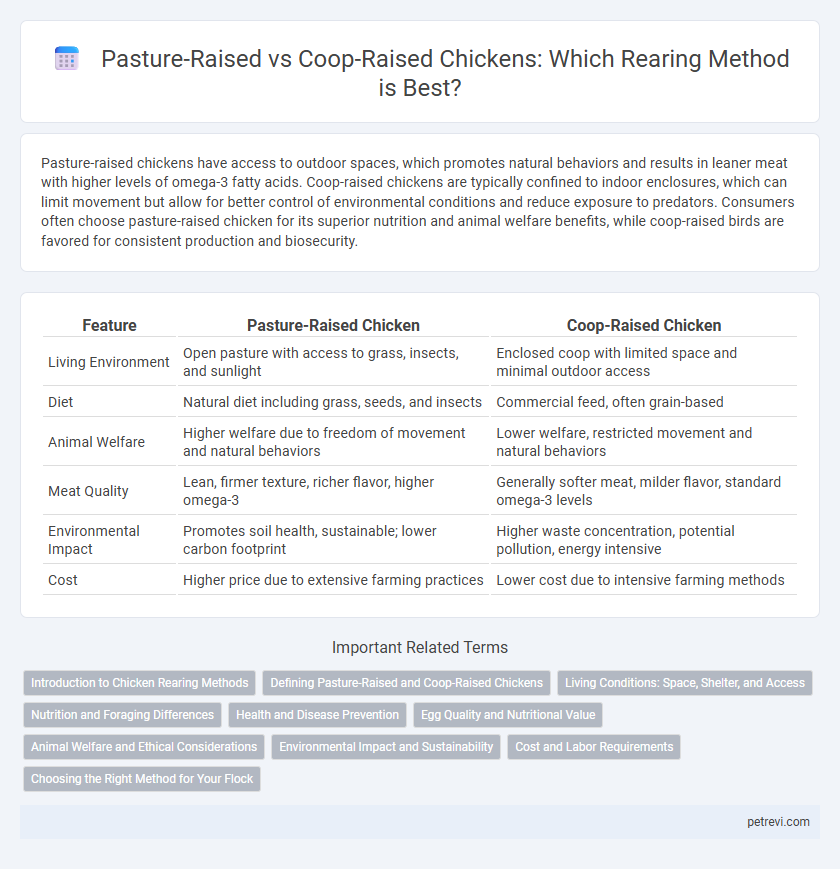Pasture-raised chickens have access to outdoor spaces, which promotes natural behaviors and results in leaner meat with higher levels of omega-3 fatty acids. Coop-raised chickens are typically confined to indoor enclosures, which can limit movement but allow for better control of environmental conditions and reduce exposure to predators. Consumers often choose pasture-raised chicken for its superior nutrition and animal welfare benefits, while coop-raised birds are favored for consistent production and biosecurity.
Table of Comparison
| Feature | Pasture-Raised Chicken | Coop-Raised Chicken |
|---|---|---|
| Living Environment | Open pasture with access to grass, insects, and sunlight | Enclosed coop with limited space and minimal outdoor access |
| Diet | Natural diet including grass, seeds, and insects | Commercial feed, often grain-based |
| Animal Welfare | Higher welfare due to freedom of movement and natural behaviors | Lower welfare, restricted movement and natural behaviors |
| Meat Quality | Lean, firmer texture, richer flavor, higher omega-3 | Generally softer meat, milder flavor, standard omega-3 levels |
| Environmental Impact | Promotes soil health, sustainable; lower carbon footprint | Higher waste concentration, potential pollution, energy intensive |
| Cost | Higher price due to extensive farming practices | Lower cost due to intensive farming methods |
Introduction to Chicken Rearing Methods
Pasture-raised chicken rearing involves allowing birds to roam freely on open grasslands, promoting natural foraging behaviors and higher animal welfare standards. In contrast, coop-raised chickens are typically confined to enclosures with controlled environments, optimizing space and facilitating disease management. Understanding these methods highlights differences in meat quality, nutritional content, and ethical considerations essential for consumers and producers.
Defining Pasture-Raised and Coop-Raised Chickens
Pasture-raised chickens are reared outdoors with access to natural vegetation, insects, and ample space to roam, promoting organic foraging behavior and healthier muscle development. Coop-raised chickens are primarily housed in enclosed structures with limited outdoor access, relying more on controlled feed and regulated environments. These distinct rearing methods impact chicken health, welfare standards, and nutritional profile of the meat and eggs produced.
Living Conditions: Space, Shelter, and Access
Pasture-raised chickens enjoy ample space to roam freely on open fields, promoting natural foraging behaviors and better muscle development compared to coop-raised chickens confined to limited indoor spaces. The shelter for pasture-raised birds typically includes movable coops or mobile shelters that protect them from predators while maintaining fresh air and sunlight exposure. In contrast, coop-raised chickens are usually housed in closed environments with restricted movement, limited natural light, and controlled ventilation, which can impact their overall health and welfare.
Nutrition and Foraging Differences
Pasture-raised chickens access diverse vegetation and insects, resulting in higher levels of omega-3 fatty acids, vitamins A and E, and antioxidants compared to coop-raised birds. Coop-raised chickens rely mainly on formulated feed, which can limit nutrient variety and reduce foraging behaviors. The natural foraging in pasture environments enhances gut health and promotes richer flavor profiles in meat and eggs.
Health and Disease Prevention
Pasture-raised chickens benefit from increased exposure to sunlight and fresh air, which enhances vitamin D synthesis and strengthens their immune systems, reducing the risk of common diseases such as coccidiosis and respiratory infections. In contrast, coop-raised chickens often face higher risks of disease transmission due to confined spaces and limited ventilation, potentially leading to outbreaks of parasites and bacterial infections like salmonella. Implementing pasture access improves overall flock health and decreases reliance on antibiotics, promoting sustainable and disease-resistant chicken rearing practices.
Egg Quality and Nutritional Value
Pasture-raised chickens typically produce eggs with higher omega-3 fatty acids, vitamin D, and beta-carotene compared to coop-raised chickens due to their access to natural forage and sunlight. In contrast, coop-raised chickens often have limited exposure to diverse diets and outdoor conditions, resulting in eggs with lower nutrient density. Research indicates that pasture-raised eggs offer enhanced nutritional benefits and improved overall egg quality.
Animal Welfare and Ethical Considerations
Pasture-raised chickens experience natural foraging behavior and more space, promoting better animal welfare compared to coop-raised chickens confined to limited spaces. Ethical considerations highlight pasture-raised methods as more humane, reducing stress and disease risk inherent in dense coop environments. This approach supports sustainable farming practices that prioritize health, welfare, and ethical treatment of poultry.
Environmental Impact and Sustainability
Pasture-raised chickens contribute significantly to environmental sustainability by supporting soil health through natural foraging and waste distribution, reducing the need for synthetic fertilizers. Coop-raised systems often rely on confined spaces that can lead to concentrated waste management challenges and higher energy consumption for ventilation and cleaning. Sustainable poultry farming favors pasture-raised methods due to enhanced biodiversity, lower carbon footprints, and improved resource efficiency.
Cost and Labor Requirements
Pasture-raised chickens typically incur higher costs due to the need for extensive land, fencing, and rotational grazing management, leading to increased labor for daily monitoring and predator protection. Coop-raised chickens often require less space and fewer resources, reducing initial setup expenses and ongoing labor but may face higher disease risk due to confinement. The choice between these methods balances cost-efficiency with labor intensity and animal welfare considerations.
Choosing the Right Method for Your Flock
Pasture-raised chickens access natural foraging environments, enhancing nutrient intake and promoting healthier growth, while coop-raised chickens benefit from controlled conditions that reduce predator risks and disease exposure. Selecting the right method depends on balancing the flock's health needs, environmental resources, and management capabilities. Optimizing flock welfare and yield involves evaluating pasture quality, coop design, and local climate to create an ideal rearing system.
Pasture-raised vs Coop-raised for Chicken Rearing Infographic

 petrevi.com
petrevi.com